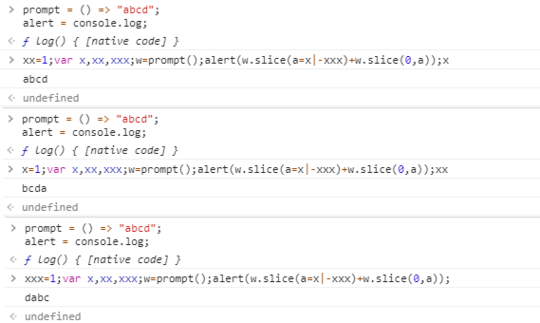22
4
A spin-off of a rip-off of a rip-off of a rip-off of a rip-off. Go upvote those!
Your task, if you accept it, is to write a program/function that outputs/returns its input/argument. The tricky part is that if I left shift your source code, the output must be left shifted too. Likewise, if I right shift your source code, the output must be right shifted too.
Source code will only be shifted once in each direction (in other words, only one shift will be applied, meaning that there are only three possible programs that need to be run). Consequently, the minimum source length should be 3.
Examples
Let's say your source code is ABC and the input is xyz. If I run ABC, the output must be xyz. But if I run BCA instead, the output must be yzx. And if I run CAB, the output must be zyx.
Let's say your source code is EFG and the input is Hello. If I run EFG, the output must be Hello. If I run GEF, the output must be oHell. And if I run FGE, the output must be elloH.
Let's say your source code is abcde and the input is 2019. If I run abcde, the output must be 2019. But if I run eabcd instead, the output must be 9201. And if I run bcdea, the output must be 0192.
Rules
- The program must print the entire output shifted in the specified direction
- Input can be taken in any convenient format.
- Output can be in any convenient format as well.
- Standard Loopholes are forbidden.
- Source length should be at least 3 characters long, as to allow for unique shifted programs.
Scoring
This is code-golf so the answer with the fewest amount of bytes wins.
Leaderboards
Here is a Stack Snippet to generate both a regular leaderboard and an overview of winners by language.
To make sure that your answer shows up, please start your answer with a headline, using the following Markdown template:
# Language Name, N bytes
where N is the size of your submission. If you improve your score, you can keep old scores in the headline, by striking them through. For instance:
# Ruby, <s>104</s> <s>101</s> 96 bytes
If there you want to include multiple numbers in your header (e.g. because your score is the sum of two files or you want to list interpreter flag penalties separately), make sure that the actual score is the last number in the header:
# Perl, 43 + 2 (-p flag) = 45 bytes
You can also make the language name a link which will then show up in the leaderboard snippet:
# [><>](http://esolangs.org/wiki/Fish), 121 bytes
var QUESTION_ID=196864;
var OVERRIDE_USER=78850;
var ANSWER_FILTER="!t)IWYnsLAZle2tQ3KqrVveCRJfxcRLe",COMMENT_FILTER="!)Q2B_A2kjfAiU78X(md6BoYk",answers=[],answers_hash,answer_ids,answer_page=1,more_answers=!0,comment_page;function answersUrl(d){return"https://api.stackexchange.com/2.2/questions/"+QUESTION_ID+"/answers?page="+d+"&pagesize=100&order=desc&sort=creation&site=codegolf&filter="+ANSWER_FILTER}function commentUrl(d,e){return"https://api.stackexchange.com/2.2/answers/"+e.join(";")+"/comments?page="+d+"&pagesize=100&order=desc&sort=creation&site=codegolf&filter="+COMMENT_FILTER}function getAnswers(){jQuery.ajax({url:answersUrl(answer_page++),method:"get",dataType:"jsonp",crossDomain:!0,success:function(d){answers.push.apply(answers,d.items),answers_hash=[],answer_ids=[],d.items.forEach(function(e){e.comments=[];var f=+e.share_link.match(/\d+/);answer_ids.push(f),answers_hash[f]=e}),d.has_more||(more_answers=!1),comment_page=1,getComments()}})}function getComments(){jQuery.ajax({url:commentUrl(comment_page++,answer_ids),method:"get",dataType:"jsonp",crossDomain:!0,success:function(d){d.items.forEach(function(e){e.owner.user_id===OVERRIDE_USER&&answers_hash[e.post_id].comments.push(e)}),d.has_more?getComments():more_answers?getAnswers():process()}})}getAnswers();var SCORE_REG=function(){var d=String.raw`h\d`,e=String.raw`\-?\d+\.?\d*`,f=String.raw`[^\n<>]*`,g=String.raw`<s>${f}</s>|<strike>${f}</strike>|<del>${f}</del>`,h=String.raw`[^\n\d<>]*`,j=String.raw`<[^\n<>]+>`;return new RegExp(String.raw`<${d}>`+String.raw`\s*([^\n,]*[^\s,]),.*?`+String.raw`(${e})`+String.raw`(?=`+String.raw`${h}`+String.raw`(?:(?:${g}|${j})${h})*`+String.raw`</${d}>`+String.raw`)`)}(),OVERRIDE_REG=/^Override\s*header:\s*/i;function getAuthorName(d){return d.owner.display_name}function process(){var d=[];answers.forEach(function(n){var o=n.body;n.comments.forEach(function(q){OVERRIDE_REG.test(q.body)&&(o="<h1>"+q.body.replace(OVERRIDE_REG,"")+"</h1>")});var p=o.match(SCORE_REG);p&&d.push({user:getAuthorName(n),size:+p[2],language:p[1],link:n.share_link})}),d.sort(function(n,o){var p=n.size,q=o.size;return p-q});var e={},f=1,g=null,h=1;d.forEach(function(n){n.size!=g&&(h=f),g=n.size,++f;var o=jQuery("#answer-template").html();o=o.replace("{{PLACE}}",h+".").replace("{{NAME}}",n.user).replace("{{LANGUAGE}}",n.language).replace("{{SIZE}}",n.size).replace("{{LINK}}",n.link),o=jQuery(o),jQuery("#answers").append(o);var p=n.language;p=jQuery("<i>"+n.language+"</i>").text().toLowerCase(),e[p]=e[p]||{lang:n.language,user:n.user,size:n.size,link:n.link,uniq:p}});var j=[];for(var k in e)e.hasOwnProperty(k)&&j.push(e[k]);j.sort(function(n,o){return n.uniq>o.uniq?1:n.uniq<o.uniq?-1:0});for(var l=0;l<j.length;++l){var m=jQuery("#language-template").html(),k=j[l];m=m.replace("{{LANGUAGE}}",k.lang).replace("{{NAME}}",k.user).replace("{{SIZE}}",k.size).replace("{{LINK}}",k.link),m=jQuery(m),jQuery("#languages").append(m)}}body{text-align:left!important}#answer-list{padding:10px;float:left}#language-list{padding:10px;float:left}table thead{font-weight:700}table td{padding:5px} <script src="https://ajax.googleapis.com/ajax/libs/jquery/2.1.1/jquery.min.js"></script> <link rel="stylesheet" type="text/css" href="https://cdn.sstatic.net/Sites/codegolf/primary.css?v=f52df912b654"> <div id="language-list"> <h2>Winners by Language</h2> <table class="language-list"> <thead> <tr><td>Language</td><td>User</td><td>Score</td></tr></thead> <tbody id="languages"> </tbody> </table> </div><div id="answer-list"> <h2>Leaderboard</h2> <table class="answer-list"> <thead> <tr><td></td><td>Author</td><td>Language</td><td>Size</td></tr></thead> <tbody id="answers"> </tbody> </table> </div><table style="display: none"> <tbody id="answer-template"> <tr><td>{{PLACE}}</td><td>{{NAME}}</td><td>{{LANGUAGE}}</td><td><a href="{{LINK}}">{{SIZE}}</a></td></tr></tbody> </table> <table style="display: none"> <tbody id="language-template"> <tr><td>{{LANGUAGE}}</td><td>{{NAME}}</td><td><a href="{{LINK}}">{{SIZE}}</a></td></tr></tbody> </table> 
Is I/O flexible? May input and output be a vector of characters? – Robin Ryder – 2019-12-10T20:50:33.027
@RobinRyder updated the question to allow flexible IO – Lyxal – 2019-12-10T20:53:07.747
Is trailing whitespace acceptable? – frank – 2019-12-10T21:08:06.333
Trailing and leading whitespace are both acceptable. – Lyxal – 2019-12-10T21:09:03.470
For that matter, comments are allowed as well. – Lyxal – 2019-12-10T21:09:18.587
6How is the empty string shifted? Does it even have to be handled? – Post Rock Garf Hunter – 2019-12-10T21:17:29.533
What about newlines? – S.S. Anne – 2019-12-11T17:48:55.450
Going from ABC to BCA or CAB is rotating, not shifting. – David Conrad – 2019-12-13T00:06:29.480